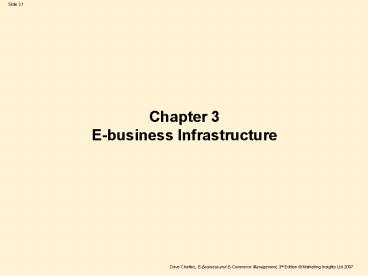Chapter 3 Ebusiness Infrastructure PowerPoint PPT Presentation
1 / 31
Title: Chapter 3 Ebusiness Infrastructure
1
Chapter 3E-business Infrastructure
2
Learning outcomes
- Outline the hardware and software technologies
used to build an e-business infrastructure within
an organisation and with its partners - Outline the hardware and software requirements
necessary to enable employee access to the
Internet and hosting ofe-commerce services.
3
Management issues
- What are the practical risks to the organization
of failure to manage e-commerce infrastructure
adequately? - How should staff access to the Internet be
managed?
4
Why the jargon?
- Why do business managers need to know about the
jargon and technology?
5
Activity 3.1 Infrastructure issues
- Make a list of the potential problems for users
of e-business services developed by The B2C
Company. - You should consider problems faced by users of
e-business applications who are both internal and
external to the organization. - Base your answer on problems you have experienced
on a web site that can be related to network,
hardware and software failures or problems with
data quality.
6
Typical problems
- Web site communications too slow.
- Web site not available.
- Bugs on site through pages being unavailable or
information typed in forms not being executed. - Ordered products not delivered on time.
- E-mails not replied to.
- Customers privacy or trust is broken through
security problems such as credit cards being
stolen or addresses sold to other companies.
7
Figure 3.1 A five-layer model of e-business
infrastructure
8
Table 3.1 Key management issues of e-business
infrastructure
9
Table 3.1 Key management issues of e-business
infrastructure (Continued)
10
Activity Internet infrastructure components
- Write down all the different types of hardware
and software involved from when a user types in a
web address such as www.google.com to the web
site being loaded.
11
Figure 3.2 Physical and network infrastructure
components of the Internet(Levels IV and III in
Figure 3.1)
12
Table 3.2 Six stages of advances in the
dissemination of information
13
Figure 3.3 A five-layer model of e-business
infrastructure
14
Figure 3.4 The Netcraft index of number of
servers Source Netcraft Web Server Survey.
http//news.netcraft.com/archives/web server
survey.html. Netcraft, http//netcraft.com
15
Figure 3.5 The relationship between intranets,
extranets and the Internet
16
Activity a common problem with intranets and
extranets
- The B2B Company has found that after an initial
surge of interest in its intranet and extranet,
usage has declined dramatically. Many of the
warning signs mentioned in the KM (2002) article
listed above are evident. The e-business manager
wants to achieve these aims - 1. Increase usage.
- 2. Produce more dynamic content.
- 3. Encouraging more clients to order (extranet).
- What would you suggest?
17
Suggested answer
- Identify benefits
- Involve staff with development
- Find system sponsors, owners and advocates
- Train on benefits
- Keep content fresh, relevant and where possible,
fun - Use e-mail to encourage usage.
18
Figure 3.6 Firewall positions within the
e-business infrastructure of theB2B company
19
Figure 3.7 Information exchange between a web
browser and web server
20
Figure 3.8 The TCP/IP protocol
21
URLS and domain names
- Web addresses are structured in a standard way as
follows - http//www.domain-name.extension/filename.html
- What do the following extensions or global top
level domains stand for? - .com
- .co.uk, .uk.com
- .org or .org.uk
- .gov
- .edu, .ac.uk
- .int
- .net
- .biz
- .info
22
HTML and XML
- HTML (Hypertext Markup Language) A standard
format used to define the text and layout of web
pages. HTML files usually have the extension
.HTML or .HTM. - XML or eXtensible Markup Language
- A standard for transferring structured data,
unlike HTML which is purely presentational.
23
Figure 3.9 Home page index.html for The B2B
Company in a web browser showing HTML source in
text editor
24
Figure 3.10 (a) Fragmented applications
infrastructure, (b) integrated applications
infrastructure Source Adapted from Hasselbring
(2000)
25
XML example
- Productgt
- ltAction Value5Delete/gt
- ltProductIDgt118003-008lt/ProductIDgt
- lt/Productgt
- ltProduct Type5Good SchemaCategoryRef5C43171801
gt - ltProductIDgt140141-002lt/ProductIDgt
- ltUOMgtltUOMCodedgtEAlt/UOMCodedgtlt/UOMgt
- ltManufacturergtCompaqlt/Manufacturergt
- ltLeadTimegt2lt/LeadTimegt
- ltCountryOfOrigingt
- ltCountrygtltCountryCodedgtUSlt/CountryCodedgtlt/Countrygt
- lt/CountryOfOrigingt
26
Media standards
- GIF (Graphics Interchange Format) A graphics
format and compression algorithm best used for
simple graphics - JPEG (Joint Photographics Experts Group) A
graphics format and compression algorithm best
used for photographs - Streaming media. Sound and video that can be
experienced within a web browser before the whole
clip is downloaded e.g. Real Networks .rm format - Video standards include MPEG and .AVI
- Sound standards include MP3 and WMA
27
Figure 3.11 Differing use of applications at
levels of management within companies
28
Figure 3.12 Elements of e-business
infrastructure that require management
29
Activity how would you respond
- You are e-commerce manager for the BBC.
- How would you evaluate your response to the
launch of the 3G phone. - That is which sources would you use to base your
response on?
30
Figure 3.13 Mobile access technologies
31
Figure 3.14 Components of an interactive digital
TV system

